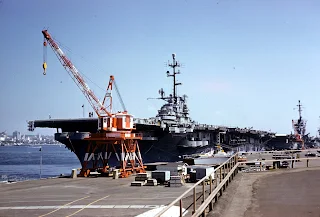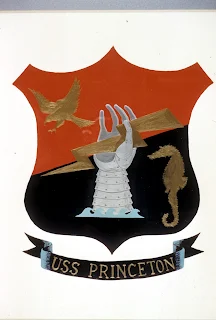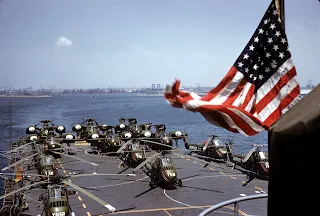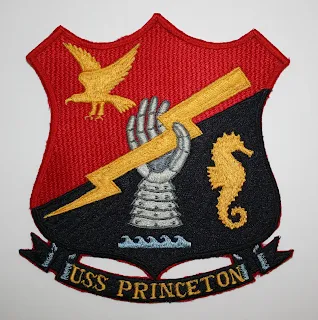Having the very good fortune of attending Princeton University on an NROTC Scholarship, I graduated in June 1958 (yes, at that time Princeton still had ROTC Units) with an Ensign’s commission in the United States Navy. My first duty assignment was in the USS Princeton (CVS-37) as an engineering officer. The then Bureau of Naval Personnel was transitioning to first generation computers using punch-card decks. I’ve always jokingly contended that somehow that may have contributed to my assignment.
 |
| USS Princeton (LPH-5) at the carrier piers United States Naval Air Station North Island Summer 1959, showing new hull number 5 on stack; note the San Diego skyline in background |
During the course of my tour in Princeton the United States Marine Corps developed the concept of vertical envelopment in an evolution of amphibious warfare. The USS Princeton on the west coast and the USS Boxer on the east coast were selected as the trial platforms for transitioning the concept into an operational capability. They were re-designated as LPH-5 (Landing Platform Helicopter) and LPH-4 respectively.
As a relatively minor part of that total evolution the ship needed a new insigne reflecting it’s new mission. Anyone who has been in the military knows you do not volunteer for anything, but by that time I was on reasonable terms with CAPT William L. Dawson, the Commanding Officer and CDR John I. Hardy, the Executive Officer, so I came up with what seemed like a fairly appropriate design. That was the “Old Navy”, no P.C. review boards, just get the job done. If the Skipper and the XO liked it, make it so. What was even more important I was on good terms with CDR Walter Watkins (a Mustang, i.e. all the way up through the ranks), the Chief Engineer, and the Warrant Officers and Chief Petty Officers, in the Engineering Department where I was assigned. In those days the Warrant Officers and Chiefs were next to God, and were the ones who made things happen.
The original art in model airplane dope, was done during July 1959, and submitted to Commander Naval Air Force United States Pacific Fleet for approval and authorization, which occurred 21 September 1959.
 |
| Original art and letter of approval and authorization of the insigne of the USS Princeton (LPH-5) |
 |
| Close-up of the original art for the insigne of the USS Princeton (LPH-5) |
The Princeton was in Yokosuka, Japan at the time, and as some of you ‘old salts’ can recall there was a thriving cottage industry for embroidery just outside the main gate. Seem to remember having a dozen patches made, basically the same size as the original artwork. As observant as I normally am, it wasn’t until literally decades later that I realized in setting up the original pattern the seahorse and the direction of the waves were reversed on this original batch of patches. The diving attitude of the eagle was also lost. Fortunately I kept one of the originals, which I believe now to be unique.
Initially it was with some trepidation that I considered showing images of the actual original patch, and still have reservations. However, it can be absolutely stated that unless you got the single patch directly from me, in all likelihood you have a copy! It is going be a really interesting exercise to see how long it takes to have the existing cottage industry producing fakes to start putting the 'genuine original article' up for sale. For those individuals who might be interested at this point in time, go on e-Bay and other web sites and directly compare the imagery in this article with what is being offered. I believe you will find striking differences. For the real purists and forensic badge analysts both sides of the patch are shown. It is hard for me to realize that both the original painting of the insigne and the patch are 53 years old.
Initially it was with some trepidation that I considered showing images of the actual original patch, and still have reservations. However, it can be absolutely stated that unless you got the single patch directly from me, in all likelihood you have a copy! It is going be a really interesting exercise to see how long it takes to have the existing cottage industry producing fakes to start putting the 'genuine original article' up for sale. For those individuals who might be interested at this point in time, go on e-Bay and other web sites and directly compare the imagery in this article with what is being offered. I believe you will find striking differences. For the real purists and forensic badge analysts both sides of the patch are shown. It is hard for me to realize that both the original painting of the insigne and the patch are 53 years old.
 |
| The reverse side of the same patch clearly showing the regularity and clean stitching in the embroidery |
Not a student of heraldry, the symbolism in the insigne is straightforward. The upper left part of the shield is the scarlet red of the U.S. Marine Corps, the lower right being dark navy blue of the U.S. Navy. The major element of the design is a mailed gauntlet hurling a gold lightning bolt, symbolizing the striking power of vertical envelopment. The color gold is also common to both services, and signifies the joint coordinated unity of the mission. The gauntlet/lightning bolt are rising from a set of five wave crests, the new hull number of the ship. The seahorse on the Navy side was first used in WWII insignia as a symbol of amphibious warfare. The diving eagle symbolizing the Marine helicopter component.
During my tour of duty in Princeton, we had some interesting events. One was being used as the setting for part of the movie, 'The Gallant Hours'. The following photographs are not up to the Hollywood cameramen that where on location, but hopefully a few viewers will recognize Jimmy Cagney, Dennis Weaver (television show 'Gunsmoke'), and Robert Montgomery the movie's director.
 |
| USS Princeton during night shooting of the movie, 'The Gallant Hours' |
 |
| Jimmy Cagney portraying ADM William F. 'Bull' Halsey in 'The Gallant Hours', talking to Dennis Weaver, Ward Costello is on the right hand side |
 |
| Fleet Admiral William F. "Bull" Halsey, Jimmy Cagney was well cast for the role |
 |
| Robert Montgomery behind the cameras with the hangar deck of the USS Princeton in the background |
Somehow during the same period of time I was able to modify a plastic scale model of an Essex Class aircraft to a reasonable facsimile of the Princeton's configuration at the time. For anyone that might be interested in building a similar model which was specifically designed as the USS Boxer (LPH-4), or as the Princeton, you may want to look at http://totalnavy.com/700boxer.htm. Unlike my model it comes with a complement of 8 Sikorsky UH-34J 'Seahorse' helicopters.
 |
| Starboard bow-on shot of scale model of the USS Princeton (LPH-5) built while serving in the ship circa 1959; compare the main mast antenna array to the pictures of the actual ship |
 |
| Flight deck of of scale model showing the initial configuration of deck 'spots' for the Marine helicopters |
 |
| Starboard side of scale model showing amphibious embarkation station markings, boat booms and refueling station/hose |
 |
| Port side of scale model showing deck-edge elevator, and barely discernible Efficiency Award 'E's' |
 |
| Appropriate Junior Officer's Staterooom decoration in USS Princeton (LPH-5) |
 |
| Oil painting of the USS Princeton (LPH-5) |
For those possibly interested in more information about the USS Princeton (LPH-5) you may want to go to http://www.navsource.org/archives/10/11/1105.htm.
Vintage video footage showing a Sikorsky UH-34J "Seahorse" and a Kaman UH-2A "Seasprite" helicopter operating off the flight deck of the USS Princeton (LPH-5) circa 1959.


1 comment:
Fascinating information, I thought you may be interested in my 1/350 conversion and buildup of the princeton for my father who served on her.
http://www.shipmodels.info/mws_forum/viewtopic.php?f=59&t=106423
Post a Comment